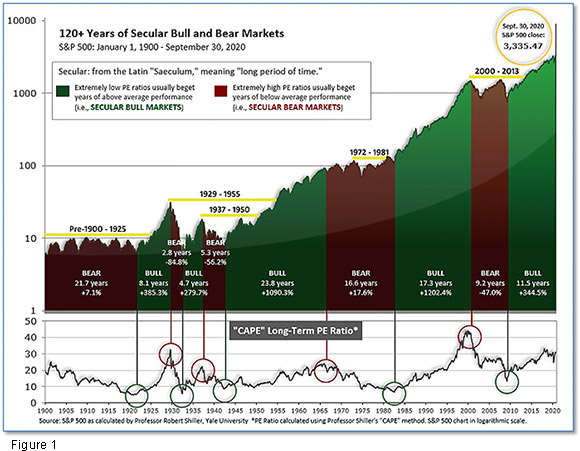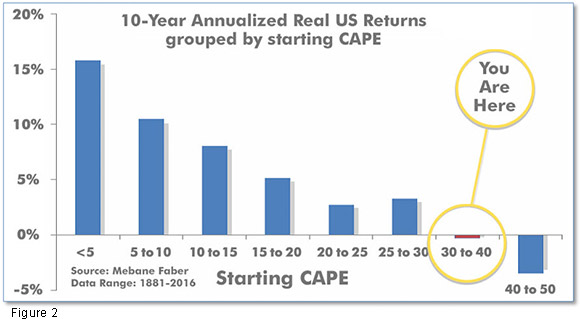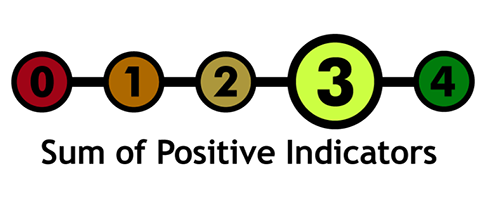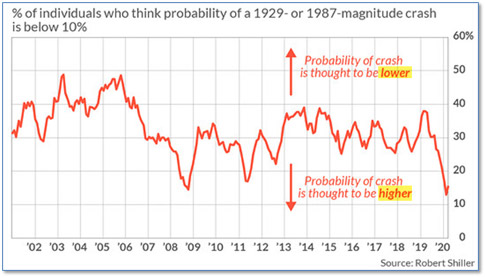NOV 2020 Valuations Remain High
Submitted by The Blakeley Group, Inc. on December 4th, 2020The very big picture (a historical perspective):
The long-term valuation of the market is commonly measured by the Cyclically Adjusted Price to Earnings ratio, or “CAPE”, which smooths-out shorter-term earnings swings in order to get a longer-term assessment of market valuation. A CAPE level of 30 is considered to be the upper end of the normal range, and the level at which further PE-ratio expansion comes to a halt (meaning that further increases in market prices only occur as a general response to earnings increases, instead of rising “just because”). The market was recently at that level.
Of course, a “mania” could come along and drive prices higher - much higher, even - and for some years to come. Manias occur when valuation no longer seems to matter, and caution is thrown completely to the wind - as buyers rush in to buy first, and ask questions later. Two manias in the last century - the “Roaring Twenties” of the 1920s, and the “Tech Bubble” of the late 1990s - show that the sky is the limit when common sense is overcome by a blind desire to buy. But, of course, the piper must be paid, and the following decade or two were spent in Secular Bear Markets, giving most or all of the mania-gains back.
The Very Big Picture: 120 Years of Secular Bulls and Bears.

See Fig. 1 for the 100-year view of Secular Bulls and Bears. The CAPE is now at 30.68, up from the prior week’s 31.47. Since 1881, the average annual return for all ten-year periods that began with a CAPE in the 20-35 range have been slightly-positive to slightly-negative (see Fig. 2).
Note: We do not use CAPE as an official input into our methods. However, if history is any guide - and history is typically ‘some’ kind of guide - it’s always good to simply know where we are on the historic continuum, where that may lead, and what sort of expectations one may wish to hold in order to craft an investment strategy that works in any market ‘season’ … whether current one, or one that may be ‘coming soon’!
The Very Big Picture: Historical CAPE Values.
Current reading: 29.90

The big picture:
As a reading of our Bull-Bear Indicator for U.S. Equities (comparative measurements over a rolling one-year timeframe), we remain in Cyclical Bull territory.
The complete picture:
Counting-up of the number of all our indicators that are ‘Up’ for U.S. Equities (see Fig. 3), the current tally is that three of four are Positive, representing a multitude of timeframes (two that can be solely days/weeks, or months+ at a time; another, a quarter at a time; and lastly, the {typically} years-long reading, that being the Cyclical Bull or Bear status).
The Current ‘Complete Picture’: The Sum of Positive Indicators.

In the markets:
U.S. Markets: U.S. stocks suffered their worst weekly declines since March, as the resurgence in coronavirus cases and election uncertainty weighed on sentiment. With the narrow exception of the S&P 500 index, all of the major indexes fell into correction territory, down over 10% from recent highs. The Dow Jones Industrial Average shed 1,834 points finishing the week at 26,502—a decline of -6.5%. The technology-heavy NASDAQ Composite fell for a second consecutive week, giving up -5.5%. By market cap, the large cap S&P 500 fell -5.6%, while the mid cap S&P 400 and small cap Russell 2000 fell more, -5.7% and -6.2% respectively.
International Markets: International markets were a sea of red this week. Canada’s TSX gave up -4.4%, while the United Kingdom’s FTSE fell -4.8%. On Europe’s mainland, France’s CAC 40 shed -6.4% while Germany’s DAX plunged ‑8.6%. Asia markets fared better; China’s Shanghai Composite declined -1.6% and Japan’s Nikkei retreated ‑2.3%. As grouped by Morgan Stanley Capital International, developed markets ended down -5.5%, while emerging markets retreated -3.5%.
Commodities: Gold finished down a third week, retreating -1.3% to $1879.90 per ounce, while silver declined -4.2% to $23.65. Crude oil plunged 10.2% to its lowest closing price since May. West Texas Intermediate crude oil finished the week at $35.79 per barrel. The industrial metal copper, viewed by some analysts as a barometer of world economic health due to its wide variety of uses, finished the week down -2.6%.
October Summary: For the month of October, the Dow gave up -4.6% and the NASDAQ declined -2.3%. The S&P 500 declined for a second month, retreating -2.8%, while previously underperforming mid caps and small caps rose 2.1% and 2%, respectively. International markets were mostly negative for October. Canada ended down -3.4% and the UK gave up -4.9%. France and Germany declined -4.4% and -9.4%, respectively. China managed a 0.2% rise, while Japan ended down -0.9%. As grouped by Morgan Stanley Capital International, developed markets finished the month down -3.6%, but emerging markets rose 1.4%. Precious metals ended the month mixed. Gold gave up -0.8% while Silver rose 0.7%. Oil finished down -11%, while Copper managed to rise 0.6%.
U.S. Economic News: The number of Americans filing for first-time unemployment benefits slipped further in the last week hitting its lowest level since the pandemic began. The Labor Department reported initial jobless claims fell by 40,000 to 751,000 last week. Economists had expected a reading of 770,000. Continuing claims, which counts the number of Americans already receiving benefits fell by 709,000 to a seasonally-adjusted 7.76 million. Economists remain concerned that rising coronavirus cases will lead people to stay home, causing service industries to begin another round of layoffs. Furthermore, Congress went home for the presidential election without passing additional coronavirus financial relief. Ian Shepherdson, chief economist at Pantheon Macroeconomics wrote, “We think initial claims are more likely to increase over the next month than to fall further.”
Home prices rose at their fastest pace in two years according to S&P CoreLogic. S&P’s Case-Shiller 20-city price index posted a 5.2% annual price increase in August, up 1.1% from the previous month. The reading was in line with analyst expectations. On a monthly basis, the index increased 0.5% in August. The separate national home price index noted a 5.7% increase in home prices across the U.S. over the past year. This is the fastest pace in more than two years. Furthermore, the price increases were broad-based. All of the 19 large cities tracked by Case-Shiller posted increases in housing prices in August. Phoenix once again led all other markets nationwide with a 9.9% annual price gain in August, followed by Seattle with an 8.5% increase and San Diego with a 7.6% increase. Phoenix has been the strongest housing market for 15 months.
The housing market generally slows in the fall, but the latest data from the Census Bureau shows sales are still running well ahead of last year’s pace. New home sales ran at a seasonally-adjusted annual rate of 959,000. While that number is a 3.5% drop from August, new home sales are up 32% compared to the same time last year. Last month, the government had reported that new-home sales had exceeded an annual rate of 1 million for the first time since 2006. Economists had expected new home sales to increase to a median pace of 1.033 million. By region, new homes plunged 28.9% in the Northeast, followed by smaller declines in the Midwest and the South. Comparatively, the West was the only region to experience an increase in sales with a 3.8% jump. The median sales price in July was $326,800, up from August’s median price. The inventory of new homes was 284,000, representing a 3.6-month supply at the current pace of sales. A 6-month supply is considered the benchmark for a balanced market.
Confidence among the nation’s consumers waned this month, reflecting less optimism about the jobs market and the U.S. economy in the next six months amid a new outbreak of coronavirus cases. The Conference Board reported its index of consumer confidence dipped a point to 100.3 this month. The decline was slightly bigger than Wall Street had expected. In the details, the sub-index that gauges how consumers feel right now about the economy rose to 104.6 from 98.9 in the prior month. However, another gauge that assesses how Americans view the next six months, the so-called ‘future expectations index’, declined to 98.4 from 102.9. The latest survey was largely compiled before the sharp upturn in coronavirus cases this month, suggesting confidence could suffer an even bigger decline in November.
Orders for goods expected to last at least three years, so-called “durable goods”, climbed 1.9% in September, its fifth consecutive month of growth. The increase in orders last month easily topped Wall Street expectations. Economists had forecast a 0.2% decline. Orders for new cars and trucks increased 1.5% last month, snapping back from sharp decline in August. Outside of transportation, orders were mixed. Core orders, a category which excludes the volatile transportation and defense segments, increased 1% last month and exceeded pre-crisis levels for the second month in a row. Paul Ashworth, chief U.S. economist wrote in a note to clients, “The 1.9% rise in durable goods orders in September demonstrates that the economic recovery isn’t entirely dependent on consumers, with business equipment investment recording a swift bounce back to pre-pandemic levels.”
GDP rebounded by a record annual pace in the third quarter, but a resurgence of coronavirus cases threatens to derail the recovery. The Commerce Department reported GDP soared 33.1% in the third quarter as the economy began to recover from the coronavirus pandemic. The widely expected snapback in gross domestic product was given a huge assist by trillions of dollars in government stimulus. However, most of the aid has now expired and another surge in coronavirus cases threatens to force the economy back into lockdown. The increase in third-quarter GDP matched the forecasts of economists. However, economists are expecting a much weaker 4th quarter. Paul Ashworth, chief economist at Capital Economics wrote in a note to clients, “With coronavirus infections hitting a record high in recent days and any additional fiscal stimulus unlikely to arrive until, at the earliest, the start of next year, further progress will be much slower.”
The Chicago Federal Reserve reported overall economic activity across the country ticked down for a third consecutive month in September. The Chicago Fed’s National Activity Index ticked down 0.84 point to 0.27 last month. The index’s three-month moving average, smoothed to iron-out the monthly volatility, moved down to 1.33 from 3.22 in August. A zero value of the index indicates the national economy is expanding at its historic trend rate of growth. Of the 85 economic indicators the Chicago Fed examines, fifty made positive contributions to the index. The third straight month of weaker readings fits with worries that the economy is faltering even as additional fiscal support for the economy remains blocked in Congress.
International Economic News: Canada’s Finance Minister Chrystia Freeland stated ending emergency spending too early would be a mistake. Speaking to the Toronto Global Forum, Freeland argued the federal government can afford to continue spending on emergency support programs for businesses and individuals and that ending them too early would imperil the eventual economic recovery. "We have a moral imperative, but also a hard economic imperative … to fight the coronavirus with all our might, and to provide our people and our businesses with a bridge to get through to the other side," Freeland said. Freeland was the keynote speaker for the final day of the three-day event, which brought together politicians, business leaders and academics from around the world to exchange views on global economic issues.
The Bank of England is expected to increase the size of its asset purchase program by a further 100 billion pounds according to a poll of economists. The increase would take the overall stimulus to 845 billion pounds ($1.1 trillion), almost double the level before the pandemic. The Bank of England’s response to the coronavirus pandemic has been one of the most aggressive among the world’s central banks. HSBC said it expected all nine BoE rate-setters to vote for a 100 billion-pound increase, including Chief Economist Andy Haldane who had sounded upbeat about the outlook until recently. That would probably give the central bank enough firepower to keep on buying British government bonds until next June, when it might have a clearer view on whether it is prepared to cut rates below zero for the first time.
On Europe’s mainland, France and Germany imposed new lockdowns this week as coronavirus activity rebounds in Europe. German officials agreed to impose a four-week partial lockdown and the French government announced a nationwide lockdown as European governments sought to stop a fast-rising wave of coronavirus cases sweeping the continent. “We are deep in the second wave,” European Commission President Ursula von der Leyen told reporters. German officials have agreed to a four-week shutdown of restaurants, bars, cinemas, theaters and other leisure facilities in a bid to curb a sharp rise in coronavirus infections, according to Chancellor Angela Merkel. Merkel said, “We must act, and now, to avoid an acute national health emergency.” In France, more than half of the country’s intensive care units are already occupied by COVID-19 patients. “(France has been) overpowered by a second wave,” Macron said.
In Asia, China’s economy is expected to grow at its weakest pace in over four decades despite its slow but steady recovery from the coronavirus-induced plunge earlier this year. The world’s second-biggest economy is now expected to expand by 2.1% in 2020, according to the median of 37 analysts. This is down slightly from the 2.2% growth projected in the last poll in July. That would make China the only major economy to grow in 2020. Further, according to a Reuter’s poll of economists, China’s economy could rebound sharply in 2021. Growth is projected to pick up to 8.4% in 2021, as the global economy is set to recover from the health crisis, according to the poll.
Japan’s new Prime Minister, Yoshihide Suga, stated his country is committed to reaching a target of zero emissions of greenhouse gases and achieving a carbon-neutral society by 2050. Suga outlined the major move in his country's attitude toward climate change in his first policy speech to Japan's parliament since taking office last month. "Responding to climate change is no longer a constraint on economic growth," Suga said. "We need to change our thinking to the view that taking assertive measures against climate change will lead to changes in industrial structure and the economy that will bring about great growth."
Finally: Given the market turmoil of this past week, investors might find solace in this item. Nobel prize-winning Yale University Finance Professor Dr. Robert Shiller reports that most investors now expect the U.S. stock market to crash like it did in 1929 or 1987. Why is that good news? Because “most investors” are usually wrong at critical turning points. He has documented that extremes in investor sentiment are actually pretty reliable contrarian indicators. In September, Shiller’s U.S. Crash Confidence Index remained near a record low of 15% (meaning 85% of respondents believe that the probability of an impending crash to be greater than 10%). The last time readings were so extreme was in the depths of the 2008-2009 bear market, before the record-breaking ten year bull market kicked off. However, Shiller cautions that most extremes in bearish sentiments are also accompanied by low market valuations, and that is not the case this time as valuations remain high.

(Sources: All index- and returns-data from Yahoo Finance; news from Reuters, Barron’s, Wall St. Journal, Bloomberg.com, ft.com, guggenheimpartners.com, zerohedge.com, ritholtz.com, markit.com, financialpost.com, Eurostat, Statistics Canada, Yahoo! Finance, stocksandnews.com, marketwatch.com, wantchinatimes.com, BBC, 361capital.com, pensionpartners.com, cnbc.com, CNBC, FactSet.)

